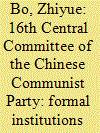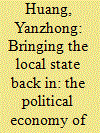|
|
|
Sort Order |
|
|
|
Items / Page
|
|
|
|
|
|
|
| Srl | Item |
| 1 |
ID:
052002


|
|
|
| 2 |
ID:
052009


|
|
|
|
|
| Publication |
May 2004.
|
| Summary/Abstract |
Since 1986 the concept of multipolarity has played a key role in China's analysis of the world order, evolving from a critique of bipolarity in the late Cold War period into a critique of American unipolarity. Although multipolarity is empirically correct in its questioning of the superpower's capacity for domination and it is ethically attractive in its insistence on international cooperation, it does not address the real problems created by the disparity of power in international affairs. Asymmetry theory is a new paradigm that addresses the effects of national disparities on international relations. It argues that asymmetry inevitably creates differences in risk perception, attention and interactive behavior between states, and that it can lead to a vicious circle of systemic misperception. Despite such tensions, however, the international order is quite stable, and even asymmetric relations can rarely be forced by the stronger side. Asymmetry confirms multipolarity's critique of unipolarity's exaggerated claim to absolute power, and suggests a theory of international leadership based on negotiated relationships that avoid the systemic misperceptions that asymmetry encourages.
|
|
|
|
|
|
|
|
|
|
|
|
|
|
|
|
| 3 |
ID:
052010


|
|
|
|
|
| Publication |
May 2004.
|
| Summary/Abstract |
Contrary to what most alarmist reports would imply, China has not witnessed a measurable decline in the overall public health status. What explains the continuous improvement in some important domains of public health despite the pertinacious pricing, financing and institutional-behavioral problems in China's health system change? This study provides a political economy analysis of the role the local Chinese state played in rural public health provision during the reform era. Through comparative case studies, statistical analysis, and formal modeling, the study shows that state capacity is a principal factor setting the parameters for rural public health in China. It also suggests that the post-Mao reforms, while generating strong disincentives for the provision of public services, unleashed forces that lay down the institutional bases for sustained state engagement in the health sector.
|
|
|
|
|
|
|
|
|
|
|
|
|
|
|
|
| 4 |
ID:
052001


|
|
|
|
|
| Publication |
May 2004.
|
| Summary/Abstract |
More than 20 years of economic reforms and opening up to the outside world have produced meaningful social, economic and political transformations in China. Have there been corresponding changes in the political-cultural orientations1
More than 20 years of economic reforms and opening up to the outside world have produced meaningful social, economic and political transformations in China. Have there been corresponding changes in the political-cultural orientations1
|
|
|
|
|
|
|
|
|
|
|
|
|
|
|
|
| 5 |
ID:
052007


|
|
|
|
|
| Publication |
May 2004.
|
| Summary/Abstract |
China and Taiwan, as well as the US, have failed to adapt new practices in response to the paradigmatic changes in the sources and nature of the China-Taiwan conflict. Reflecting the tremendous political and social change in Taiwan, China and the world that have occurred during the past 10-15 years, the most prominent source of the China-Taiwan conflict has shifted from power to identity. This article discusses the change of social identity in Taiwan and the re-emergence of nativistic nationalism in the PRC identity. The authors suggest that policymakers on all three sides could begin to re-think the Taiwan issue by taking the advantage of the ideas and the methods pioneered by experts in the rapidly growing field of conflict analysis and resolution. In this article, the author apply concepts related to identity used by practitioners in the field of conflict resolutionto look at the deeper cultural issues of identity and suggest some more appropriate methods for intervention and resolution of this deeply rooted conflict.
|
|
|
|
|
|
|
|
|
|
|
|
|
|
|
|
| 6 |
ID:
052003


|
|
|
| 7 |
ID:
052005


|
|
|
|
|
| Publication |
May 2004.
|
| Summary/Abstract |
The construction boom of the past two decades, primarily funded by the private sector, has engendered fierce aesthetic conflicts due to intense competition for limited space in rapidly modernizing Beijing. Contemporary Chinese artists both protest the commercial exploitation of traditional cultural sites, and appropriate market devices for their ends. In this article I analyze aesthetic strategies employed in experimental art, film, and fiction, which grapple with the tensions inherent in globalization and urban culture in late twentieth-century Beijing. Examples include installations protesting the forced relocation of the Central Academy of Fine Arts in 1994 to develop a 'City of Commerce' in its place, and renting the Imperial Ancestral Temple in the Forbidden City to exhibit domestic experimental art, as a foil to the orientalist productions promoted at this site. While much contemporary Beijing cultural production shares a realist, documentary drive to address urban, post-industrial anxieties relative to dislocation, Chinese artists deconstruct the present with a conspicuous absence of nostalgia. The contemporaneity of the ruin is one of the most prevalent expressions of the 1990s urban aesthetic, where the past, as human sentiment, is nonexistent. Rather than anachronistically violating chronology, these works are examples of what Ackbar Abbas terms achronicities, where past and present disappear in each other. As an aesthetic strategy, disappearance is a form of hybridity that resists delimiting not only temporal, but also conceptual and normative frames of reference. By highlighting hybrid effects rather than merely conceptualizing the tensions inherent in the global city, an aesthetics of disappearance functions as a site of resistance while also working to reposition artists at the center of commercial culture.
|
|
|
|
|
|
|
|
|
|
|
|
|
|
|
|
|
|
|
|
|